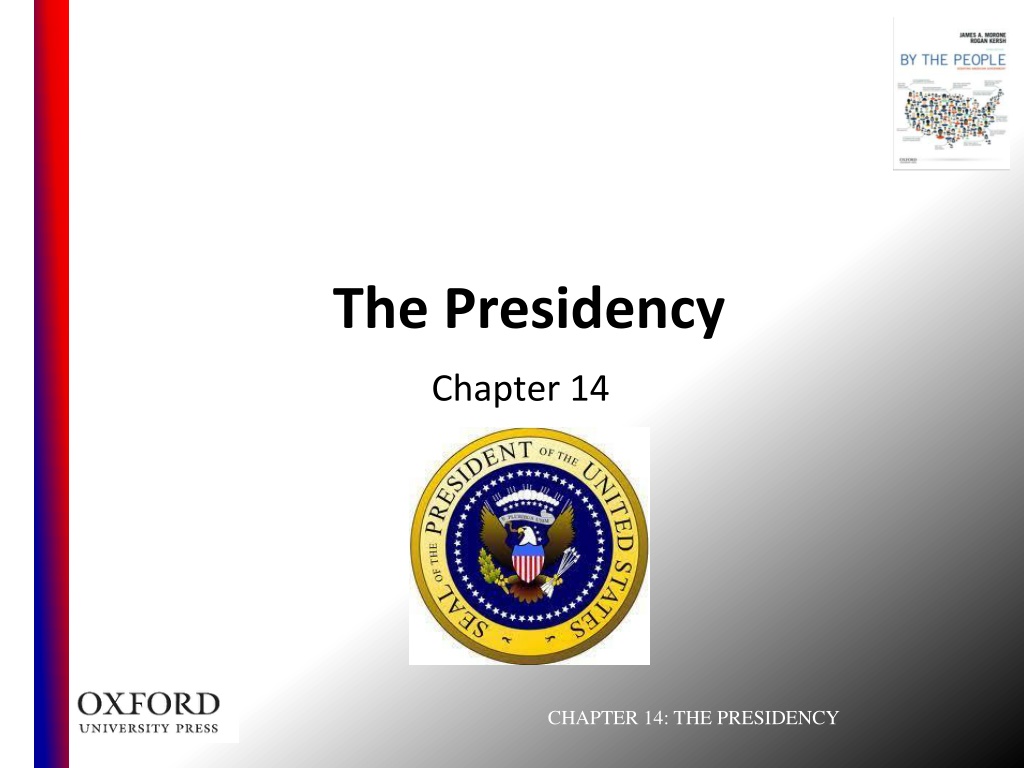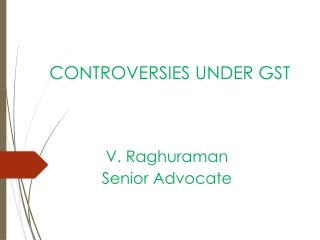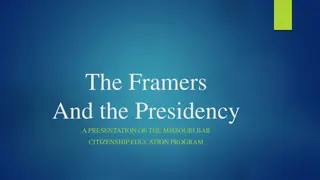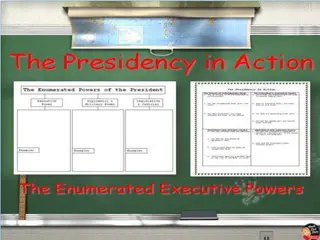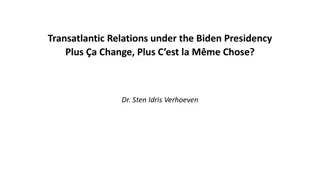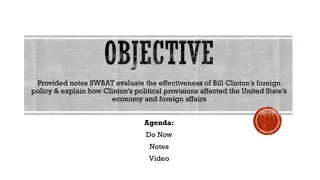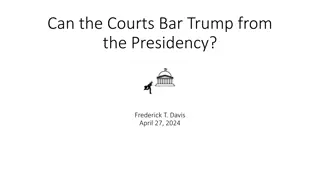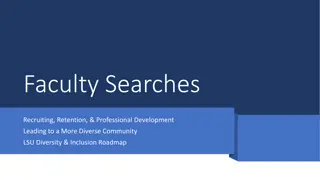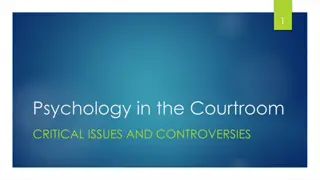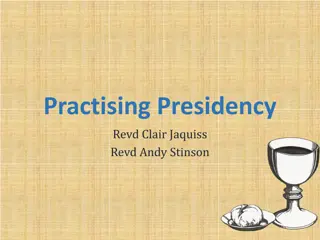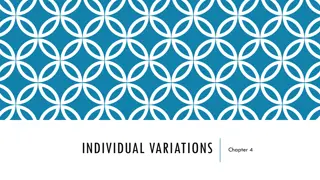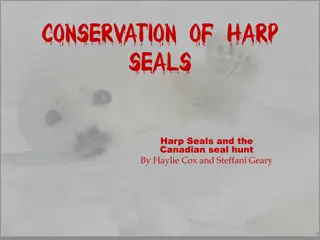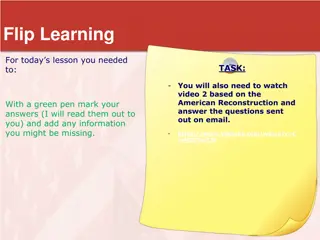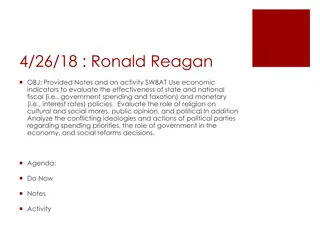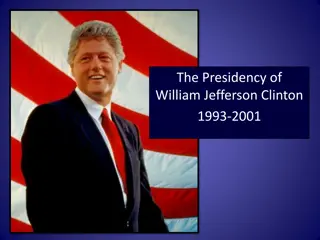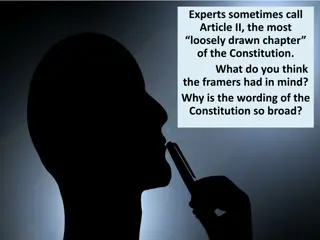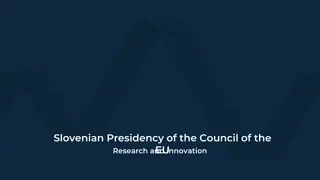Understanding the Presidency: Power, Responsibilities, and Controversies
Explore the intricacies of the presidency in Chapter 14, covering topics such as presidential power, roles, historical perspectives, and discussions on the limitations and scope of the office. Delve into the dynamic nature of the presidency, including debates on leadership versus management, counter-terrorism efforts, natural-born citizen requirements, and the evolving influence of foreign policy on the modern presidency.
Download Presentation

Please find below an Image/Link to download the presentation.
The content on the website is provided AS IS for your information and personal use only. It may not be sold, licensed, or shared on other websites without obtaining consent from the author. Download presentation by click this link. If you encounter any issues during the download, it is possible that the publisher has removed the file from their server.
E N D
Presentation Transcript
The Presidency Chapter 14 CHAPTER 14: THE PRESIDENCY
In this chapter you will learn: See how the Constitution defines the presidency. Focus on presidential power. Learn what presidents do. Reflect on presidential popularity and greatness. Consider the personal side of the office. Tour the Executive Office of the President, and meet the team around a president. CHAPTER 14: THE PRESIDENCY
Discussion Questions Pair and Share 1. What is the difference between a leader and a manager, and how does that relate to the modern presidency? 2. Has presidential power gone too far in the fight against terrorism? 3. Should the term natural-born citizen be removed as a requirement to run for the presidency? 4. What are the various roles of the president? Which presidents have excelled or not excelled in which areas? 5. How has the presidency increased in power during the twentieth and early twenty-first centuries? 6. How does foreign policy shape the modern president? 7. Does the current president excel/not excel in a particular area? CHAPTER 14: THE PRESIDENCY
Class Activities Individually rank each of presidents and compare them. Write an essay on what constitutes presidential greatness. See what it s like to be president with role-playing online game Executive Command (https://www.icivics.org/game/popout/594). CHAPTER 14: THE PRESIDENCY
Class Activities Discuss the difficulties in trying to juggle the duties and responsibilities of the presidency while simultaneously attempting to forward your chosen agenda and deal with domestic and foreign issues. The Presidential Timeline (interactive site) http://www.presidentialtimeline.org/#/home The Living Room Candidate CHAPTER 14: THE PRESIDENCY
Defining the Presidency Defined by Controversy Should there be a president? How long should the president serve? How should the president be selected? Article 2 provides minimal information re: the president s role and power in 13 paragraphs (Congress has 52). Constitution s phrasing: Take care that the laws be faithfully executed. The executive power shall be vested in a president. CHAPTER 14: THE PRESIDENCY
Defining the Presidency The President s Powers Expressed powers: Powers the Constitution explicitly grants to the president. Delegated powers: Powers that Congress passes on to the president. Inherent powers: Powers assumed by presidents, often during a crisis, on the basis of the constitutional phrase, The executive power shall be vested in the president. Executive privilege: Power claimed by the president to resist requests for authority by Congress, the courts, or the public. Not mentioned in the Constitution but based on the separation of powers. Executive agreements: an international agreement made by the president that does not require the approval of the Senate. CHAPTER 14: THE PRESIDENCY
Is the Presidency Too Powerful? An Imperial Presidency? Unitary executive theory: The idea that the Constitution puts the president in charge of executing the laws and that therefore no other branch may limit presidential discretion over executive matters. Imperial presidency: A characterization of the American presidency that suggests it is demonstrating imperial traits, and that the republic is morphing into an empire. CHAPTER 14: THE PRESIDENCY
Is the Presidency Too Powerful? A Weak Office? Even under the best of circumstances, it s difficult to get major legislation through Congress because the president s vetoes can be overridden, and Congress retains the power of impeachment. CHAPTER 14: THE PRESIDENCY
What Presidents Do Commander in Chief The president shall be the Commander-in-Chief of the Army and Navy of the United States and the militia of the several states, when called into the actual service of the United States. Congress declares war and presidents manage it. CHAPTER 14: THE PRESIDENCY
What Presidents Do Top Diplomat Presidents have the lead role in foreign affairs. CHAPTER 14: THE PRESIDENCY
What Presidents Do The First Legislator Recommending Measures. Each president begins their term with a few legislative priorities, but many others inevitably arise. State of the Union. An annual event, delivered with great fanfare before Congress, Supreme Court justices, and a national television audience, this speech announces the president s legislative program for the year. Presidential Batting Average. We measure each president s legislative success by the successful passage as a proportion of all the bills the president endorses, of the most important bills, or of bills that the other party opposes. CHAPTER 14: THE PRESIDENCY
What Presidents Do The First Legislator (cont.) Veto power: The presidential power to block an act of Congress by refusing to sign it. Override. The process by which Congress can overcome a presidential veto with a two-thirds vote in both chambers. Presidents have 10 days to return the legislation to Congress with a message explaining why he or she has rejected it. If the president does nothing, the bill becomes law in ten days. Signing Statements.These may offer the president s interpretation of the law one sometimes at odds with Congress s expressed ideas. CHAPTER 14: THE PRESIDENCY
What Presidents Do Chief Bureaucrat Appointments. The Constitution gives the president the power to appoint the men and women of the executive branch of government, subject to confirmation by the Senate. Executive Orders. This is a presidential declaration, with the force of law, that issues instructions to the executive branch without any requirement for congressional action or approval. (The Supreme Court has the power, however, to overrule an executive order found to be unconstitutional.) CHAPTER 14: THE PRESIDENCY
What Presidents Do Economist in Chief Economic authority is one item the Constitution definitely does not grant the president, but the president is considered to be responsible for a smooth-running economy. CHAPTER 14: THE PRESIDENCY
What Presidents Do The Head of State The president is the ceremonial head of state who stands above partisan politics and represents the nation. CHAPTER 14: THE PRESIDENCY
What Presidents Do Party Leader Presidents must perform complicated balancing acts to avoid charges of blatant partisanship (leveled by the other party) and failing to adequately support their party colleagues. CHAPTER 14: THE PRESIDENCY
What Presidents Do The Bully Pulpit: Introducing Ideas Theodore Roosevelt called the presidency itself a bully pulpit an active president has the country s ear, an opening to introduce and promote new ideas. CHAPTER 14: THE PRESIDENCY
What Presidents Do The Impossible Job No one person can juggle so many different presidential roles; even great presidents cannot handle all their jobs well all of the time. CHAPTER 14: THE PRESIDENCY
Presidential Leadership: Success and Failure in the Oval Office Managing the Public Presidents develop a relationship with the people, which they cultivate by going public directly addressing citizens in order to win support. CHAPTER 14: THE PRESIDENCY
Presidential Leadership: Success and Failure in the Oval Office Approval Ratings Polls are used widely as a rough barometer of the administration s success. CHAPTER 14: THE PRESIDENCY
Presidential Leadership: Success and Failure in the Oval Office Presidential Greatness The authors believe that great presidents redefine America; they reshape the way the nation sees itself. CHAPTER 14: THE PRESIDENCY
Presidential Leadership: Success and Failure in the Oval Office Greatness in Context: The Rise and Fall of Political Orders Step 1: A New Order Rises. Outstanding leaders take over the presidency and shake up the political system. Step 2: The Order Refreshed. The ideas begin to look out of date; the great coalition begins to unravel. Step 3: The Old Order Crumbles. Over time, the party finds its ideas increasingly irrelevant. The old order feels outdated, a political dinosaur. CHAPTER 14: THE PRESIDENCY
The Personal Presidency Presidential Style James Madison was guided by a fierce attachment to the Constitution that he had drafted and believed the office was greater than the man. Richard Nixon was brilliant and often paranoid, traits that helped him ratchet down the bitter cold war by playing off our enemies against one another. Ronald Reagan loved to tell stories and paint a gauzy vision of American free enterprise. CHAPTER 14: THE PRESIDENCY
The Personal Presidency The Burden of the Office 14 presidents and former presidents died during the twentieth century. 11 passed away prematurely. Eight of them fell more than seven years short of expected life spans for men of their age. CHAPTER 14: THE PRESIDENCY
The Presidents Team: A Tour of the White House The Political Solar System: Presidential Appointments The executive branch is like the solar system, with the president as the sun and his appointees rotating around him. CHAPTER 14: THE PRESIDENCY
The Presidents Team: A Tour of the White House The Vice President Presides over the Senate and casts a vote in case of a tie; otherwise, his responsibilities are entirely up to the president. CHAPTER 14: THE PRESIDENCY
The Presidents Team: A Tour of the White House The Cabinet Members of the cabinet have two primary roles: they run executive- branch departments, and they meet to discuss policy with the president in cabinet meetings. CHAPTER 14: THE PRESIDENCY
The Presidents Team: A Tour of the White House The Executive Office of the President The Office of Management and Budget (OMB). This is the most powerful agency in the executive branch it uses its authority over the federal budget to manage the entire executive branch. The Council of Economic Advisers (CEA). The Council and its chair keep an eye on the whole economy; CEA staff perform economic analysis for the president: unemployment predictions, productivity measurements, economic forecasts, etc. CHAPTER 14: THE PRESIDENCY
The Presidents Team: A Tour of the White House The Executive Office of the President (cont.) The National Security Council (NSC). The NSC brings together the powerful officers who make national security policy: secretaries of state, defense, intelligence, and the treasury (economists again); the chair of the Joint Chiefs of Staff; and others whom the president selects. The national security advisor directs the council and must work for consensus across all the different perspectives and formidable personalities: diplomatic, military, and economic. CHAPTER 14: THE PRESIDENCY
The Presidents Team: A Tour of the White House The Heart of Power: The White House Office (WHO) This group of four hundred or so advisors, aides, and associates works directly for the president, most of them in the West Wing. At the center sits the Chief of Staff, the president s gatekeeper, traffic cop, and coordinator. Other important offices include speechwriters, White House counsel (the president s official lawyer), and the legislative affairs team. Unlike the high-ranking members of the cabinet agencies, most EOP staffers are not subject to Senate confirmation. CHAPTER 14: THE PRESIDENCY
Crash Course Presidential Power: Crash Course Government and Politics #11 https://www.youtube.com/watch?v=5l02sK5LovI Presidential Powers 2: Crash Course Government and Politics #12 https://www.youtube.com/watch?v=fnHb-zyWh14 How Presidents Govern: Crash Course Government and Politics #14 https://www.youtube.com/watch?v=5vnuFJSMYkY CHAPTER 14: THE PRESIDENCY
The Presidents Team: A Tour of the White House The First Spouse Traditionally, the First Lady role was simply that of hostess, but Eleanor Roosevelt broke the traditional mold and pioneered a new role: the First Lady as activist. CHAPTER 14: THE PRESIDENCY
Why has the role of first spouse increased in importance to political scientists recently? CHAPTER 14: THE PRESIDENCY
Conclusion: The Most Powerful Office on Earth? The Oval Office reverberates with power and responsibility, but it is also full of limitations, checks, and balances. CHAPTER 14: THE PRESIDENCY
Topics for Discussion How has the presidency increased in power during the twentieth and early twenty-first centuries? What are the central roles of the modern presidency? How does foreign policy shape the modern president? What is the role of Article 2 in the presidency? CHAPTER 14: THE PRESIDENCY
